You're Destroying Your Truck's Paint: The Truth About Automated Car Washes
Author Bio: Danny is a co-owner of Driveway Dreams, an ASE Certified Master Technician with over 26 years of experience, and previous freelance writer for Car Engineer. For more than 17 years, he's owned and operated his own independent repair shop in Livonia, Michigan. Subscribe and follow, Danny!
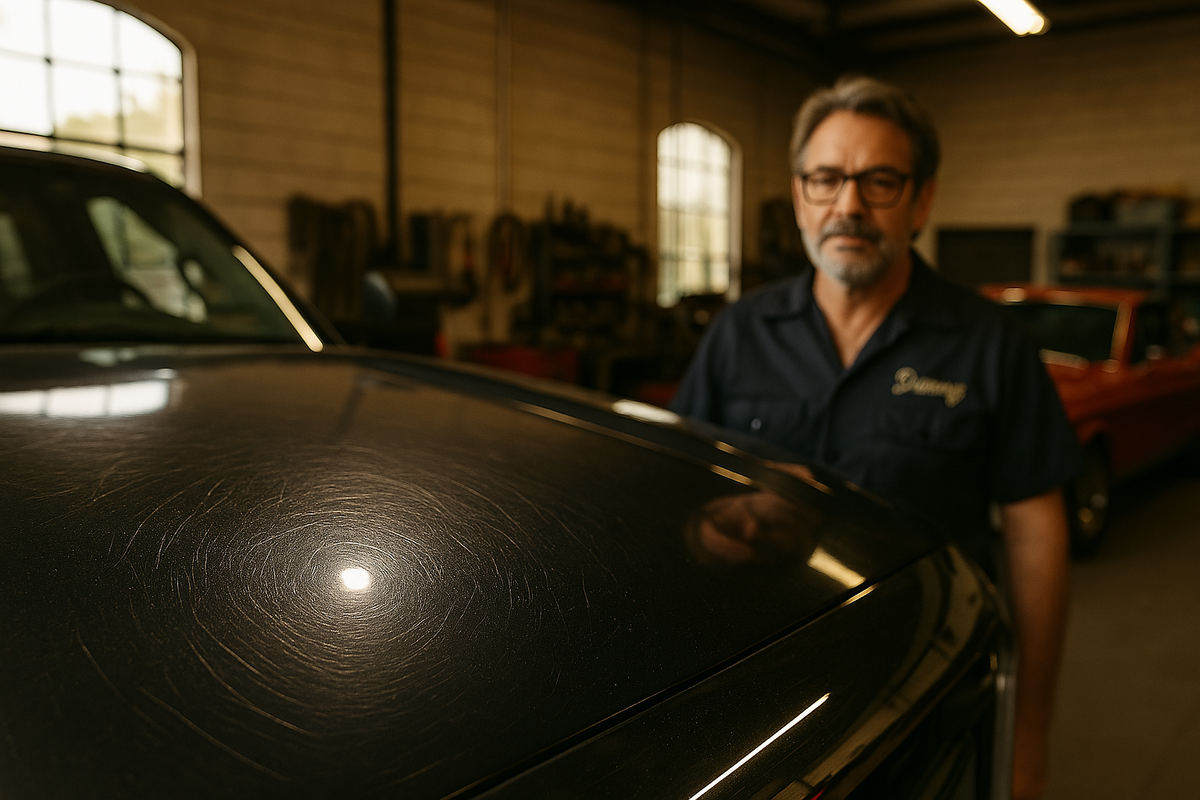
Are those quick drive-thru car washes actually wrecking your truck’s paint?
Let me be blunt: Absolutely. Every time you roll your shiny F-150 or 4Runner into that automated wash, you might as well be sandblasting your clear coat. It’s the dirty secret no one at the gas station will tell you. And the damage isn’t just cosmetic – it hits you in the wallet when your vehicle’s value drops or you shell out hundreds to fix the mess. Buckle up, because I’m about to expose exactly how these “conveniences” are destroying your paint, and how to save your truck from this silent paint killer. Using a complete wash kit with the right tools can save your vehicle from thousands in damage.
The Convenience Trap: Why We Love (and Overuse) Automatic Washes
The Numbers Don't Lie: Why So Many Choose Automatic Washes
You’re busy, it’s winter in the Rust Belt, your SUV’s covered in salt – so you think, “Ten bucks for a quick wash, why not?” In fact, over 50% of American drivers regularly use in-bay automatic car washes. Many wash their cars about once a month at these places (DetailPro). It feels like a cheap, time-saving solution. Heck, I’ve seen local washes offer unlimited monthly deals for $9.99 that are practically irresistible – unlimited washes! No wonder a guy on Reddit bragged about using a new RAV4’s unlimited wash pass until he noticed the brushes had scratched the entire side of his 2023 RAV4 right through the clear coat (r/rav4club). A proper wash mitt would have prevented this damage.
The Hidden Costs of Convenience
The convenience is a trap. Automatic washes thrive on our impatience. Consider these facts:
- The car wash industry rakes in $15-18 billion a year in the US alone
- Each wash gradually degrades your paint through micro-scratches and harsh chemicals
- Many drivers pay for monthly "unlimited" plans, maximizing paint damage
- As one detailer noted, "You can only polish a clear coat so many times before it's gone"
Let me put it this way: taking your truck through an automatic wash is like letting a toddler with sandpaper hands give it a hug every week. Sure, it might look temporarily cleaner, but those fine scratches and chemical etchings build up until your paint looks hazy and swirled. Don't get lazy. You'll regret it once you see exactly what horrors are happening in those five minutes of soapy mayhem.
Key Takeaway:
The convenience of automatic washes comes at a high cost to your paint. That $10 quick wash is actually an investment in future damage that will cost hundreds to repair.
Acid Baths and Cheap Soaps: What’s Really Spraying on Your Paint
Dangerous Chemicals Your Paint Is Exposed To
Think the "foam" they use is just gentle soap and water? Think again. Most automated car washes use:
- Hydrofluoric acid (HF) - The same acid infamous from Breaking Bad, used as a pre-wash cleaner
- Sodium hydroxide - Industrial-strength lye that cuts through grease but is highly corrosive
- High-alkaline detergents - Strip protective wax and dry out plastic trim and rubber seals
- Silicone-based "wax" - Cheap spray that provides minimal protection for a day or two at most

Let that sink in: Hydrofluoric acid (HF) – HF is so dangerous the CDC issued warnings to car wash workers about exposure (Thrillist). On your paint, this acid strips away wax, eats into sealants, and can even dull the clear coat over time.
These chemicals don't discriminate – they'll happily strip off the protective wax you applied and dry out your plastic trim and rubber seals. Unlike these harsh chemicals, pH-balanced car shampoos clean without stripping protection. Ever notice faded gray trim on older cars? Cheap detergents are often to blame. The “cheaper” the car wash, the crappier the soap – many use bulk detergents not much gentler than dish soap. They’ll leave your paint “clean” but completely unprotected, having blasted off any previous wax.
What Those Chemical Colors Really Mean
I’ve looked into the ingredient lists of some bargain-basement car wash soaps and it'll make you cringe. Some are essentially caustic degreasers with a pleasant color. No wonder your paint looks dull after a while – it’s being chemically scoured. As Chemical Guys (a company known for gentler car care products) points out, “low-grade car wash soaps tend to be too strong, stripping wax off your vehicle’s surface while staining plastic and rubber parts.” By contrast, a proper pH-balanced shampoo will clean without stripping protection (Mr. Pink Car Wash Shampoo | Chemical Guys).
The Spray-On Wax Scam
One common scam is the “spray-on wax” at the end of an automatic wash. Trust me, that neon-colored “wax” is usually silicone-based junk that sits on the surface for a day or two at best. It’s no replacement for a real hand-applied wax or sealant. I call it “spray-on BS”, because it gives drivers false confidence that their paint is protected – it’s not. Meanwhile, the underlying harsh wash chemicals already eroded your last coat of real wax.
If this sounds shocking, good. You should be upset that your vehicle is getting an acid bath in the name of convenience. The next time you pull into that wash bay and see those chemical arrows (pre-soak, wash, “triple foam wax”), picture the cocktail of HF acid and lye being unleashed. It’s eating away not just the dirt, but your paint’s defensive coat. And if the chemicals don’t get you, the brushes will – which brings me to the next horror show.
Danny's Pro Tip:
If you must use an automatic wash in winter, immediately apply a spray sealant when you get home. This will help replace the protection that was stripped by the harsh chemicals.
Key Takeaway:
Automatic car washes use industrial-strength chemicals that strip away your protective wax and can damage trim, rubber seals, and clear coat over time.
Scratch City: How Automatic Brushes Turn Your Paint into Sandpaper
How Those 'Soft Touch' Brushes Really Work
Even if you opt for a “soft cloth” or brush-type automatic wash, you’re not safe. In fact, you’ve just entered Scratch City, population: your truck. Those spinning brushes and flapping cloth strips are brutal. Sure, they start out soft, but after a few cars, they’re loaded with grit. Now they’re essentially filthy mops slapping your paint at 30 MPH.
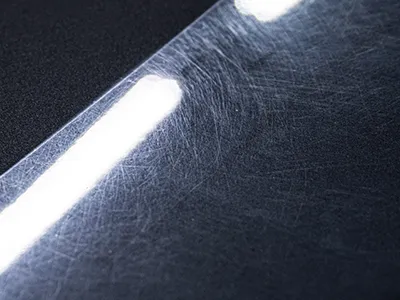
The Accumulating Damage You Can't See (Yet)
Remember the old-school car washes with giant rotating brushes that looked like monster scrubbers? Modern systems use softer materials (sometimes foam fingers or cloth strips), but “soft” doesn’t mean clean. All the dirt from the 100 cars before you is still on those brushes (Ask a Pro Blog). The wash doesn’t magically clean itself between vehicles. So when those brushes hit your paint, they’re dragging all that embedded dirt across it. Each little dirt particle becomes a piece of sandpaper, gouging tiny scratches into your clear coat.

Imagine taking a scouring pad to your truck – that’s effectively what’s happening. A Thrillist automotive writer put it perfectly: even the so-called gentle brushes “carry with them a bunch of dirt, not just from your car, but from the car in front of you… Each particle is essentially a tiny piece of sandpaper eating away at your car’s paint.”
It only takes one or two of these brush assaults to mar a perfectly polished finish. Under the fluorescent lights of my shop, I’ve seen brand-new cars with swirl marks all over because the owner used a cheap car wash from day one. Those swirls – the fine spider-web scratches you see in sunlight – are a signature of automatic brush washes. Using proper wash tools and techniques prevents this damage entirely.
Why Touchless Isn't Much Better
Even “touchless” washes can cause swirls indirectly. The high-pressure jets blast grime around, which can then get wiped across the paint when it’s blown dry or when you drive off with water still on the surface. And if you think the solution is those “free self-serve brushes” at the DIY car wash bay – forget it. Those brushes are usually trashed and full of grit as well. I’ve had customers come in baffled that their black truck is suddenly covered in swirls after using the gas station’s self-serve brush just once.
Let’s not ignore other physical damage: I’ve seen side mirrors cracked, antennas ripped off, and trim pieces yanked loose by automated washes. One detailed study by a pro detailer showed how even weather-stripping and rubber trim can be torn or lifted by high-speed spinning brush heads. If a piece of molding is a little loose, a car wash machine will find a way to rip it off. I call it the “courtesy assault” – the wash’s way of kindly removing parts of your car without asking.
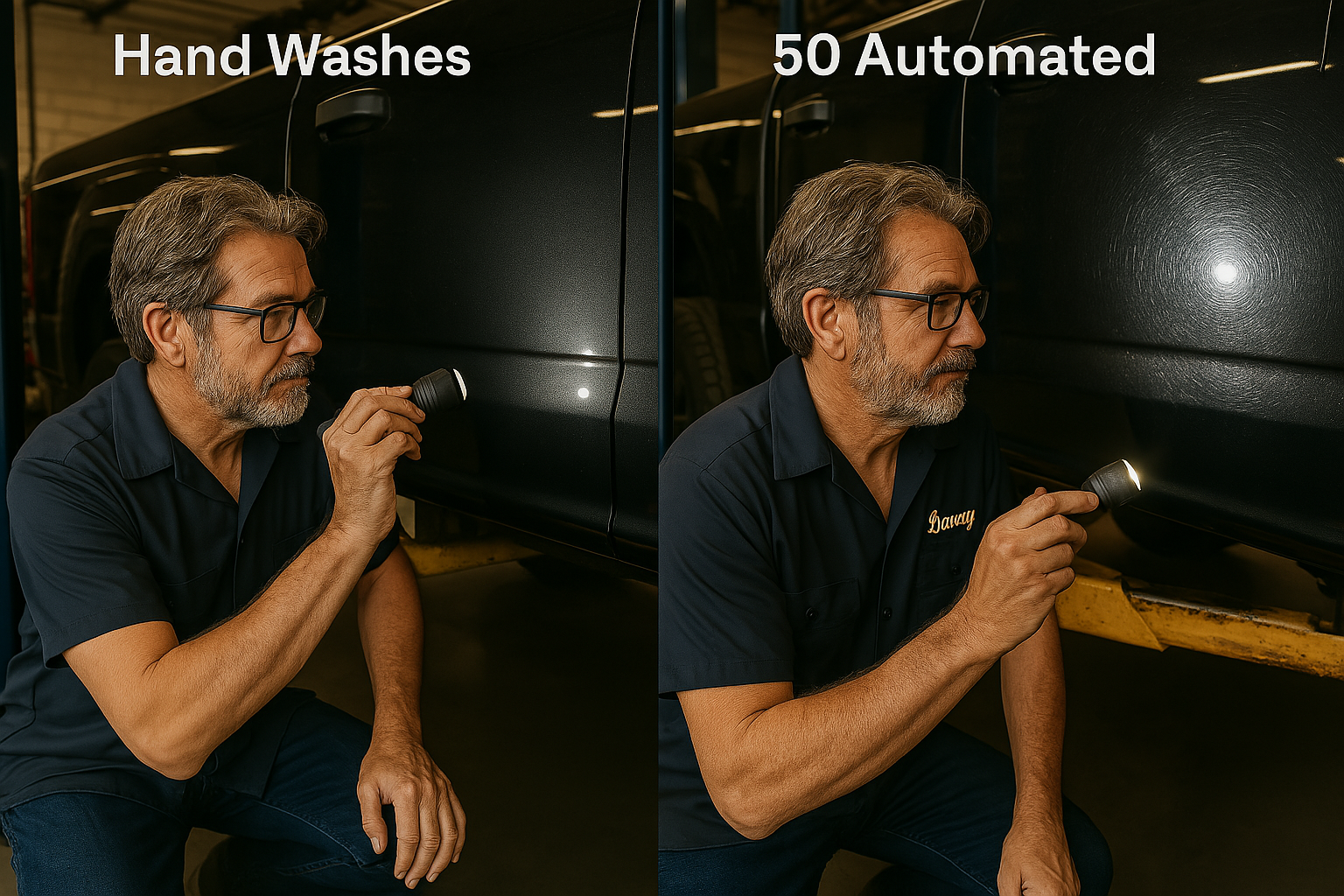
To sum it up, brush washes = swirl mark factories. Even the industry admits it. In a car wash trade study, they found that after 25 automatic washes, paint had tons of “very fine, virtually parallel scratches” (a fancy way to describe swirls) (Meguiar's Online). Those “uniform markings” are the signature of machine cleaning. The study tried to claim the paint was still in good shape – but any car enthusiast knows **swirls = damage**. It’s literally micro-abrasions all over your clear coat.
So whether it’s the chemical attack or the brush attack, automated washes have your paint in their crosshairs. The result? A vehicle that might be only a couple years old but already looks dull, with the once-deep gloss now a haze of tiny scratches. And that has real consequences when it comes to dollars and cents.
Key Takeaway:
Those "soft" brushes and cloth strips are covered in abrasive particles from previous vehicles, creating thousands of microscopic scratches (swirls) each time you wash.
Dollars Down the Drain: The Real Cost of Paint Damage
The Real Math: Automatic Wash vs. Resale Value
Some people say, “It’s just cosmetic, who cares?” Well, potential buyers care. If you plan to sell or trade-in your truck or SUV, a pristine paint job can make a big difference. A vehicle with dull, scratched paint signals neglect, even if mechanically it’s fine. I’ve been in the used car market long enough to see how swirled paint knocks down resale value. Buyers either factor in the cost of repainting/polishing, or they walk away entirely.
Think about it: Would you pay top dollar for a “mint” used truck that looks like it’s been scrubbed with steel wool? I sure wouldn’t. Even if the buyer isn’t an expert, something will look “off” about a swirly, hologram-filled finish. It lacks that deep reflection of a well-kept car. I’ve seen this first-hand: two identical year trucks, one regularly hand-washed and waxed, the other run through Mr. Whippy’s Auto Wash twice a month. The hand-washed one sold immediately at asking price. The car-washed one? Buyers low-balled it by several thousand dollars, citing the need for a paint correction or that it “looked older” than it was.
Now, if you’re leasing or trading in to a dealer, you might think they won’t notice. Wrong. They notice, and they’ll pay you less. They know they’ll have to hit it with an aggressive buffing or even repaint panels to get it lot-ready. That comes out of your pocket in the form of a lower trade value. Financially, those $10 washes could be costing you $500+ when you sell. It’s like an invisible tax you pay later.
Paint Correction Costs You Never Budgeted For
And if you decide to fix the paint? Get ready to spend:
- Professional paint correction: $300-600 for a truck or SUV, depending on severity
- Touch-ups for deeper scratches: $100-200 per area
- Panel repainting: $500-1000 per panel
- Clear coat repair: Once damaged beyond polishing, full repaint is your only option
I’ve had customers literally pay me to fix damage from the same car wash they faithfully paid for all year. One guy with a black Chevy Silverado came in fuming that his truck looked “cloudy.” Under shop lights I showed him the countless swirls. He admitted he’d been doing the $20 deluxe wash every week. We performed a multi-stage polish to restore the shine – it cost him about $800. I couldn’t help but lay it out: he basically paid the car wash $20/week to ruin his paint, then paid me $800 to fix it. That’s insane. He could have saved all that money and had a flawless truck if he’d just washed it properly himself.
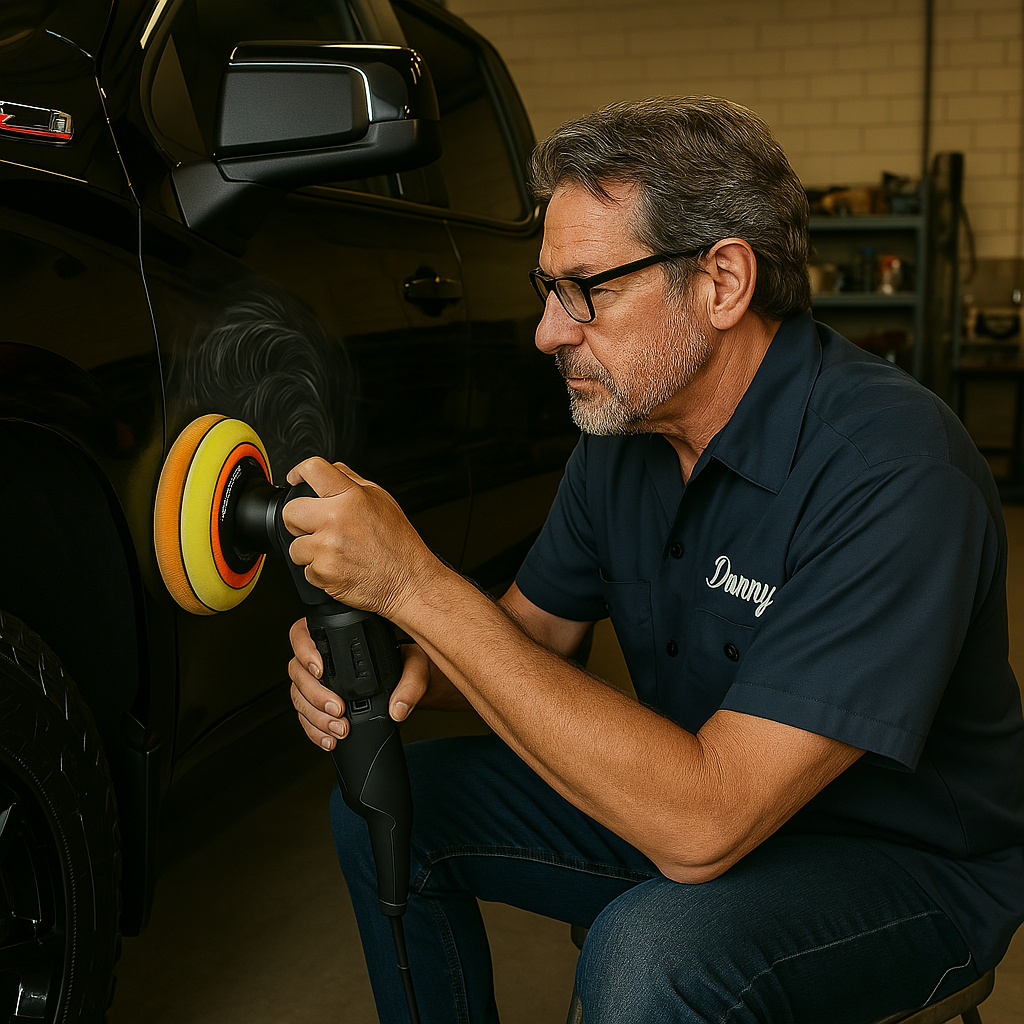
There’s also the factor of clear coat longevity. Your vehicle’s clear coat (the transparent top layer of paint) is only so thick. Every aggressive chemical attack or abrasive scrubbing thins it. You can only polish a clear coat a limited number of times before it’s gone. Once you polish out swirls, you’ve essentially shaved down the clear coat a tiny bit. Do that repeatedly and you risk burning through. If the clear coat fails, your paint is toast – it will oxidize, peel, and require a full repaint. One Reddit detailer warned, “You can only ‘cut’ or polish a clear coat so many times... If none left, you’re repainting” (r/AutoDetailing). Why accelerate the death of your clear coat with bad washing?
Long story short: Automatic washes decrease your vehicle’s value – either directly by damaging the finish, or indirectly by forcing you to spend big to restore that finish. A $40 hand wash and wax once a month might seem expensive, but compare that to a $600 correction bill or a lower resale. Penny wise, pound foolish, as they say.
Beyond Paint: Other Damage That Costs You
I’d be remiss not to mention safety, too. While not as common, I’ve seen situations where poor visibility from etched glass or hazy headlights (also victims of harsh car wash chemicals and brushes) became a safety issue at night. And those water spots that never come off your windshield because the dryer didn’t work well? They can etch into the glass and impair your view. So yes, even your glass and headlights can suffer if you constantly subject your vehicle to subpar washes.
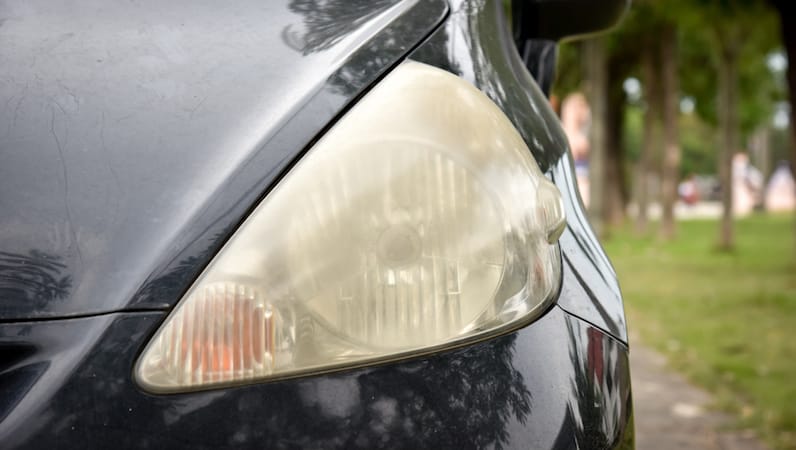
" I used to take my F-150 through the automatic wash twice a month. After following Danny's method for six months, the difference is incredible. My truck looks better than when I bought it, and a dealer offered me $1,500 more than I expected on trade-in because of the paint condition. "
— Mike D., Detroit
Alright, enough horror stories. The good news is you can keep your truck clean without trashing its paint. It just takes a little more effort (and perhaps a bit of investment in proper supplies), but the payoff is a vehicle that looks great and retains value. Let’s talk about doing it the right way – the Danny way.
Key Takeaway:
Automatic washes can cost you thousands in the long run through decreased resale value and expensive paint correction. The $480/year you spend on weekly washes could cost you an additional $1,500+ when selling your vehicle.
Wash Your Truck the Right Way: Safe Alternatives to Save Your Paint
If automatic washes are the villains, then hand washing is the hero of this story. I’ll be straight: nothing beats a proper hand wash with high-quality products. Before you groan about the effort, consider it therapy. Like one Redditor said, “Washing your own car can be therapeutic... plus you’ll do a way better job than a machine.” (r/AutoDetailing) I couldn’t agree more – throw on some music, crack a cold one (after the washing, safety first), and get to know your vehicle. It’s actually kind of fun, and the results speak for themselves.
Having the right tools is the first step to washing your vehicle safely and effectively.
Danny's Quick Start Wash Guide
- Gather supplies: Two buckets, grit guards, wash mitt, car shampoo, microfiber towels
- Pre-rinse: Thoroughly spray down vehicle to remove loose dirt
- Soap up: Fill one bucket with soapy water, one with plain rinse water
- Top-down washing: Start at roof, work downward using straight lines (not circles)
- Rinse mitt in plain water between each section to remove trapped dirt
- Regular rinsing: Rinse completed sections before soap can dry
- Proper drying: Use clean microfiber towels and blot/pat instead of wiping
Remember: Work in the shade, use plenty of water, and take your time!
If you’re really serious, a foam cannon or foam gun is a great pre-wash tool to loosen dirt (especially for big trucks). But let’s focus on the essentials and some product recommendations that I personally use and recommend to my customers
What Makes a Good Car Soap (And What Doesn't)
Your soap is critical. You want a pH-balanced, lubricant-rich shampoo that cleans without stripping wax. For example, Chemical Guys Mr. Pink Car Wash Shampoo (about $9.99 for a 16 oz bottle) is a favorite of mine. It’s tough on dirt but gentle on wax and sealant – exactly what you need for regular washes. Mr. Pink is formulated to rinse clean with no residue and has polymers that help minimize scratching. When you wash with it, you can feel how slick it is; the mitt just glides. This means less friction on your paint, reducing the chance of swirls. No more harsh detergents – Mr. Pink leaves your existing wax intact and won’t dry out your plastic trim.
Danny's Pick: Mr. Pink Car Wash Shampoo

pH-balanced formula that cleans effectively without stripping wax. Creates slick, scratch-minimizing suds.
Check Price ($9.99)For those driving lifted trucks or off-road SUVs that get extra dirty, consider a foam pre-wash. Chemical Guys Honeydew Snow Foam (about $10.99 for 16 oz (Car Wash Soap & Car Shampoo | Chemical Guys)) is a foaming soap you can spray on with a foam cannon. It produces mountains of foam that cling to the paint and start loosening grime. This is great for a touchless pre-soak at home – let the foam dwell, then rinse off most of the dirt before you ever touch the paint with a mitt. It dramatically cuts down wash-induced scratches because you’re not grinding heavy dirt into the paint. I use Honeydew Snow Foam on big, muddy F-250s that come into my shop; it turns thick muck into a gentle slurry that rinses off.
If you have stubborn dirt or want a bit more cleaning power (like after winter salted roads), a citrus-based shampoo can help. Chemical Guys Citrus Wash & Gloss (around $11.99 for 16 oz (Car Wash Soap & Car Shampoo | Chemical Guys)) contains natural citrus cleaners that cut through grime and add a gloss enhancer. It’s stronger than Mr. Pink, but still safe if diluted properly. I sometimes use Citrus Wash & Gloss in spring to strip off any old, tired wax and start fresh (using it at a higher concentration for a wax-stripping wash). It leaves the paint squeaky clean and ready for a new coat of wax. Just don’t use something like this every wash if it’s strong – reserve it for seasonal deep cleaning or really nasty jobs.
The point is: use soaps designed for automotive paint. They cost maybe $0.50-$1 per wash in product, which is nothing compared to the potential damage of cheap soap. And please, use the two-bucket method: one bucket has your soapy water, the other is plain water to rinse your wash mitt after each pass on the car. This way, you’re not reintroducing dirt to the paint. It’s a simple step that massively reduces swirl risk. Many enthusiasts also use a grit guard (a screen at the bottom of the bucket) to trap grit – another cheap insurance for your clear coat.
Danny's Pro Tip:
Always wash your vehicle in the shade or on a cloudy day. Direct sunlight heats up the paint and can cause soap to dry too quickly, leading to water spots and streaks that are difficult to remove.
Danny's Complete Wash Kit Recommendation
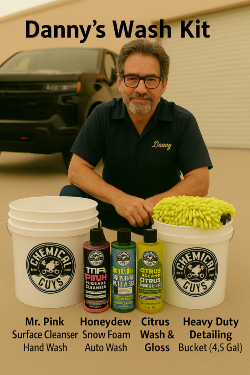
Everything you need in one package - saves over 25% vs. buying separately.
- pH-balanced soap
- Premium microfiber mitt
- Professional drying towels
Free shipping on orders over $75
Time-Saving Tools That Won't Damage Your Paint
Ditch the Old Sponge – Embrace the Wash Mitt and Microfiber
Those ratty old sponges and towels? Trash them. They trap dirt and create swirl marks. Instead, get a plush microfiber wash mitt or a natural lambswool mitt. These pull particles away from the surface into the fibers, rather than dragging them across the paint. They also hold a ton of soapy water, which lubricates the surface. When I switched customers to microfiber mitts, the difference in their paint over time was night and day.
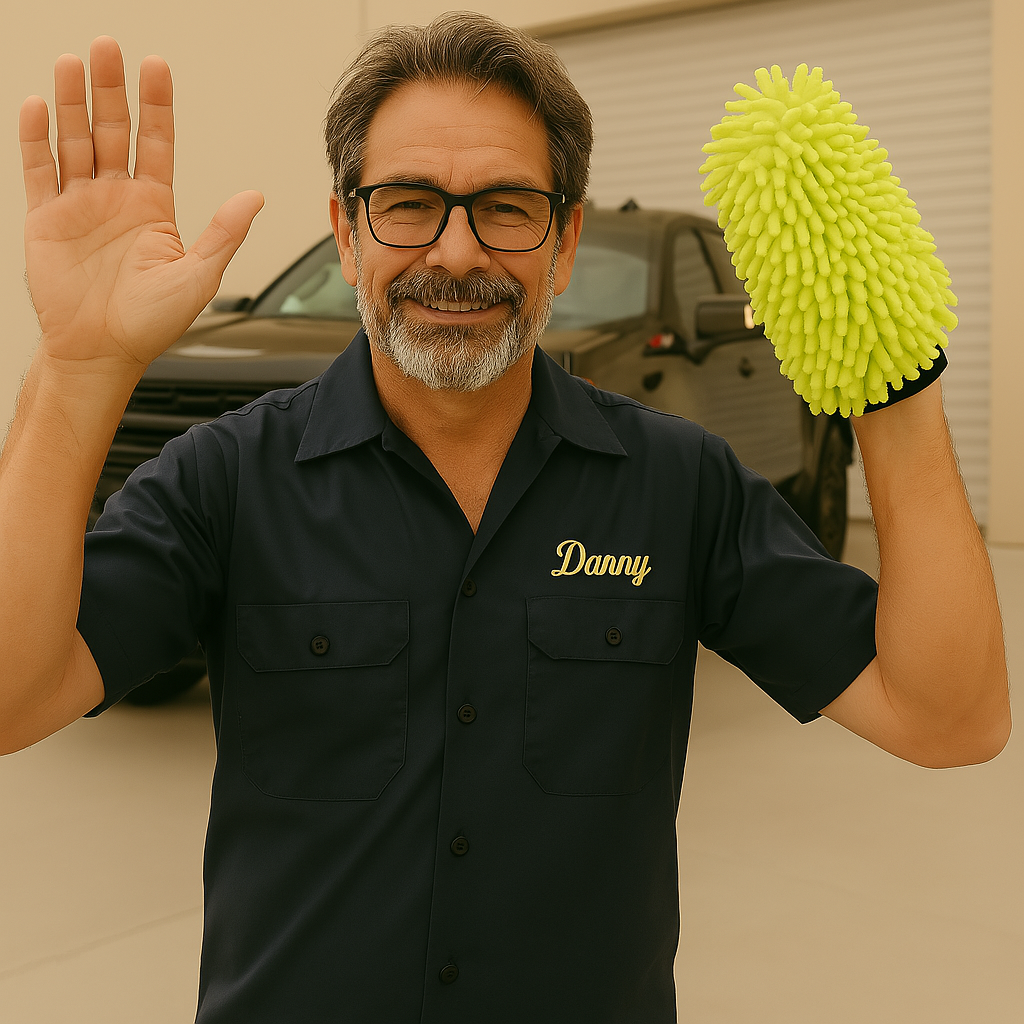
Danny's Pick: Microfiber Wash Mitt
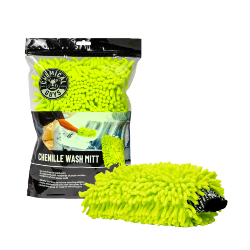
Soft microfiber pulls dirt away from paint instead of dragging it across the surface. Essential for scratch-free washing.
Check Price ($8.99)Same goes for drying: use soft microfiber drying towels or a soft waffle-weave towel. And blot or gently wipe – don’t grind the towel into the paint. If possible, rinse with free-flowing water (no nozzle) as a “sheeting rinse”; this leaves less water on the car to dry. Immediately hand-dry to avoid water spots (which are mineral deposits that can etch paint if left to bake in the sun). Pro tip: you can spray a quick detailer or drying aid while you dry, which adds lubrication and leaves a little protection behind. It makes the towel glide and prevents streaks.
Danny's Pick: Microfiber Drying Towels
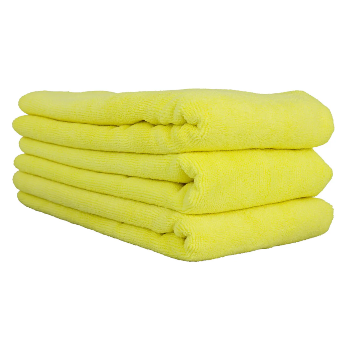
Ultra-absorbent towels for streak-free drying. Prevents water spots and scratches during the drying process.
Check Price ($16.99)If you’re in a winter climate and can’t use water outside, consider a rinseless wash product (like Optimum No Rinse, or Chemical Guys has one called EcoSmart Waterless Wash). These allow you to safely clean the car with minimal water, using a special solution and plush microfiber towels. Many detailing enthusiasts in cold areas swear by rinseless washes to survive winter without automatic washes. It’s a bit beyond the scope here, but just know you do have options in winter. Even a coin-op pressure rinse followed by a rinseless wash at home in the garage is 100x better than the swirl-o-matic.
Danny's Pick: EcoSmart Waterless Wash

Clean your vehicle with minimal water. Perfect for winter washing or areas with water restrictions.
Check Price ($14.99)Key Takeaway:
Using the two-bucket method with quality car-specific products takes a little more time but saves your paint. The right tools and techniques can make hand washing efficient while preserving your truck's finish.
Protect, Protect, Protect: Wax or Seal After Washing
Washing is only half the battle. If you stop there, your paint is clean but naked – you need to protect it. A layer of wax or sealant not only gives your paint shine and depth, it provides a sacrificial barrier that takes the brunt of UV rays, bird droppings, and yes, even the occasional drive-thru wash if you slip up. Without protection, your clear coat is exposed and will oxidize or get stained much easier. Quality waxes and sealants provide essential protection.
Wax vs. Sealant vs. Ceramic: Which Is Right For You?
For a traditional approach, a good carnauba wax like Chemical Guys Butter Wet Wax (about $19.99 for 16 oz (Butter Wet Wax | Chemical Guys)) is a great choice. It’s easy on, easy off – you literally wipe it on like butter, let it haze for a minute, then buff it off. It leaves a deep wet shine that makes your paint look like a mirror. Butter Wet Wax is made with natural carnauba and some polymers, giving you a warm glow and decent durability.
On my personal truck, I love this stuff for the “wow” factor after a wash. I usually wax every couple of months; it only takes maybe 30 minutes to do the whole vehicle. The slick surface also makes future dirt come off easier (and water beads up nicely). At under $20 a bottle, which lasts many applications, it’s a no-brainer investment in preserving your paint.
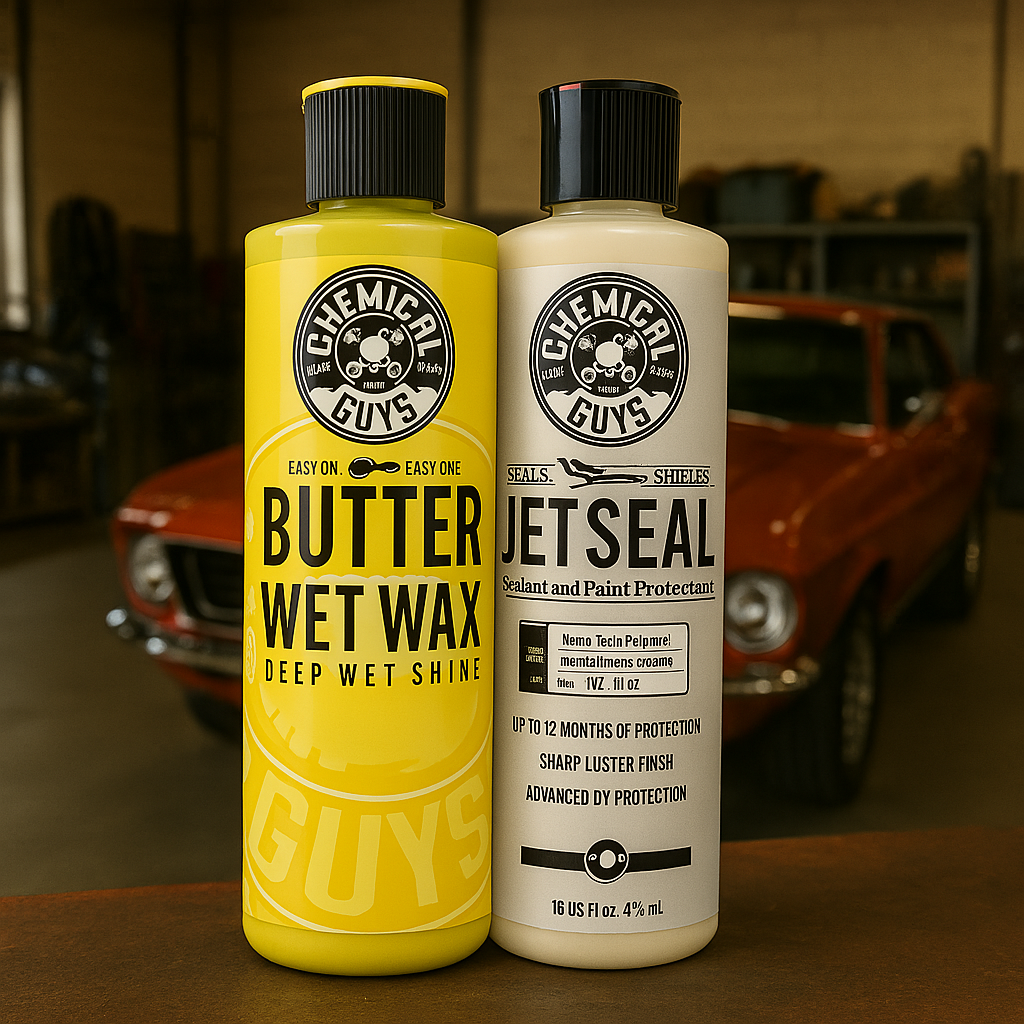
If you want longer-term protection with less frequent application, consider a paint sealant or a ceramic product. Chemical Guys JetSeal is a popular paint sealant (around $39.99 for 16 oz (Jet Seal Sealant & Paint Protectant - Chemical Guys)). It’s a synthetic polymer sealant originally developed for the aerospace industry, which means it’s designed to withstand extreme conditions. JetSeal will give you up to 6-12 months of protection, far longer than a carnauba wax. It creates a bright, reflective shine (some say not as warm as a carnauba, but very clear and glossy). I often recommend JetSeal to customers who don’t have time to wax every 2-3 months. Apply it like a wax, let it cure for 20 minutes, then buff off. Your paint will feel slick as glass. It’s excellent at guarding against UV fading, acid rain, and road salts. A sealant like this is basically a force field for your clear coat.
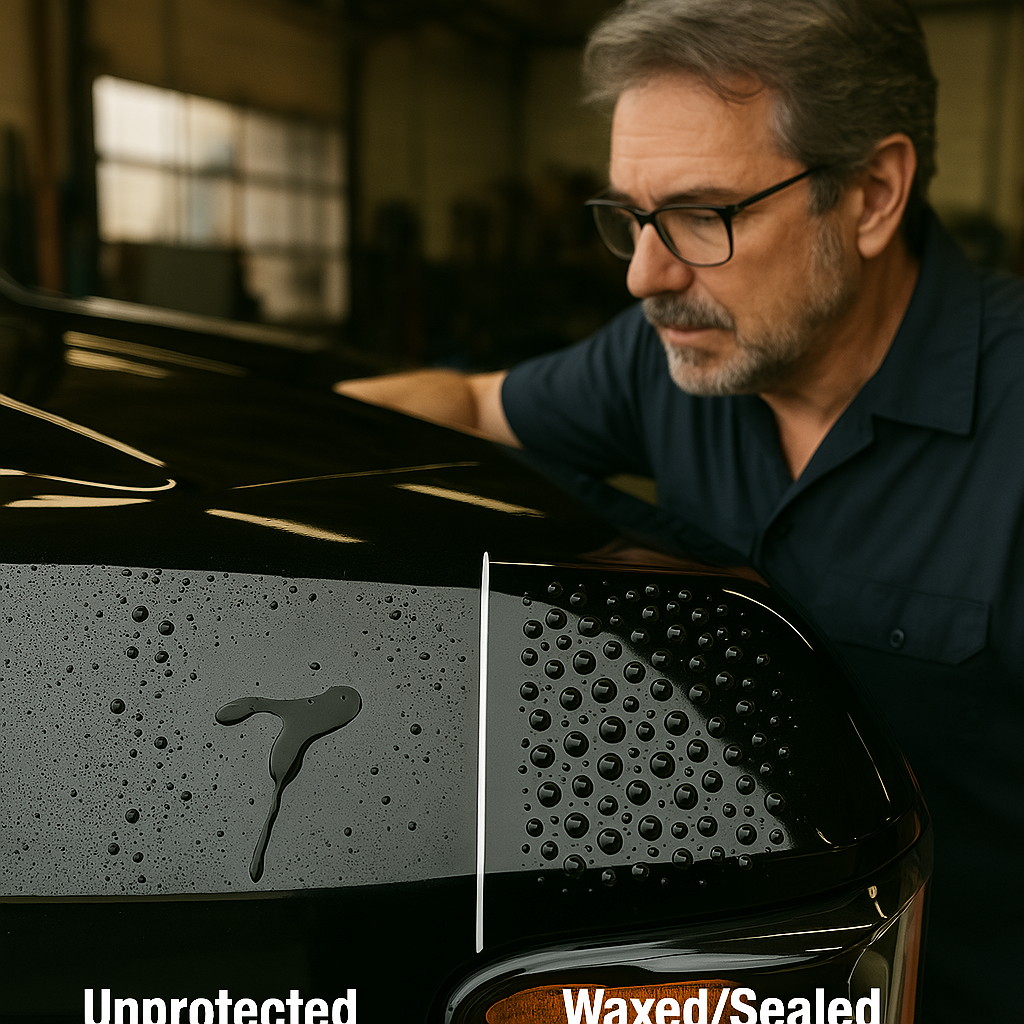
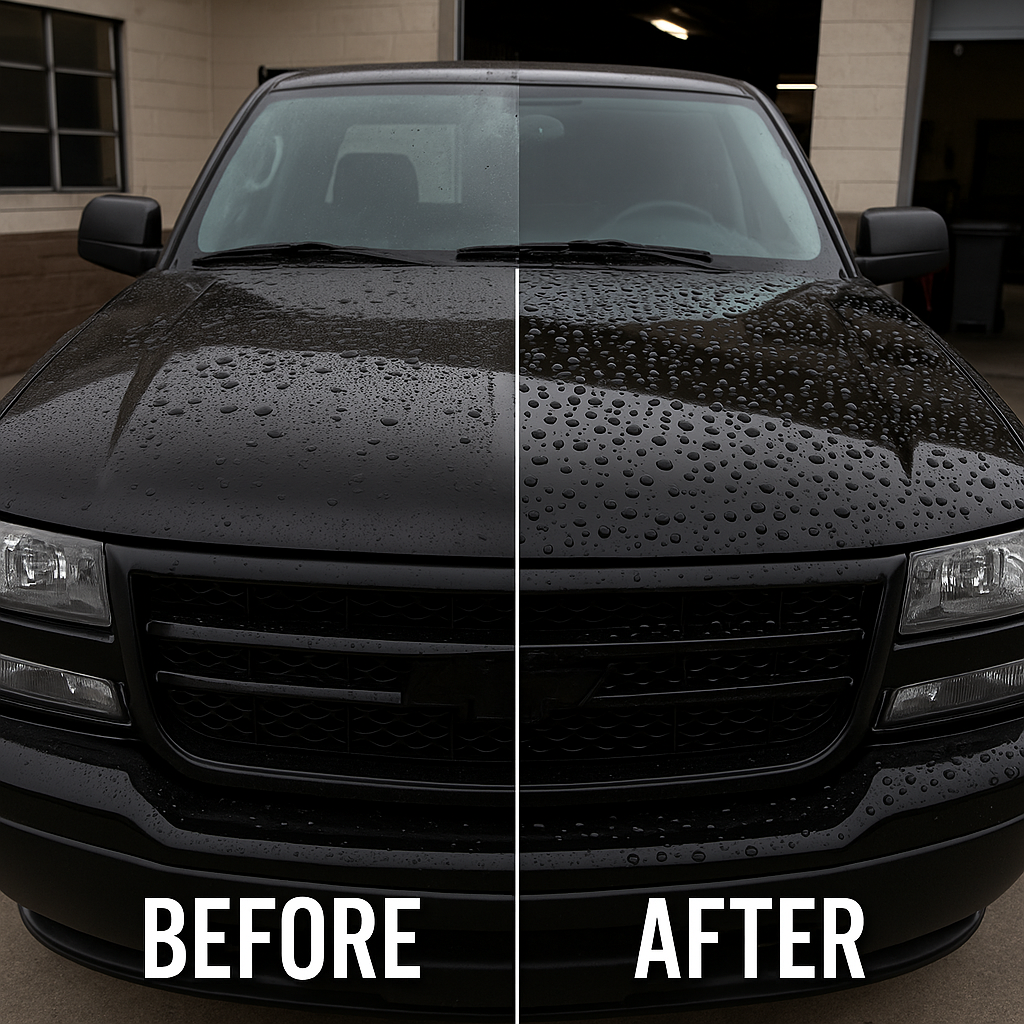
In recent years, ceramic coatings have become the ultimate paint protection, forming a nano-ceramic layer that can last 2-5 years. They’re more involved to apply (usually a pro job, though there are consumer “ceramic waxes” like Chemical Guys HydroSlick HyperWax which is $39.99 for a 16 oz gel. If you’re the meticulous type, a ceramic coating is worth considering – it will make your paint extremely resistant to chemicals and minor scratches. Water will bead and sheet off like crazy. But even a simple wax or sealant, done regularly, will put you miles ahead of the automatic car wash crowd.
Let me emphasize this: No matter how you choose to protect (wax, sealant, ceramic), using something is vital. It’s like sunscreen for your car. It not only keeps it looking good, it provides a sacrificial layer that wears away instead of your clear coat. Then you reapply, and you’ve essentially saved your paint from aging. Plus, a well-protected car is easier to wash – dirt doesn’t stick as much. So it’s a virtuous cycle: wash properly, protect, repeat. You’ll find each wash is easier and your car stays cleaner longer.
Danny's Pro Tip:
Apply wax to a clean, cool surface using a foam applicator pad in small circular motions. Work on one panel at a time and don't let the wax dry completely before buffing - this makes removal much easier.
Key Takeaway:
Paint protection is essential after washing - whether it's carnauba wax (2-3 months), synthetic sealant (6-12 months), or ceramic coating (1-5 years). This sacrificial layer takes the abuse instead of your clear coat.
When You Have No Choice: Minimizing Damage at the Automatic Wash
Look, I get it – sometimes life happens. Maybe it’s the dead of winter and you have no garage, or you’re on a road trip and just need a quick clean. If you must use an automatic wash occasionally, opt for touchless only and skip any “wax” or extra chemical add-ons. Touchless (no brushes) will rely on chemicals, but at least you avoid physical scrubbing. It’s still not great – remember the acid – but I’d take harsh soap over gritty brushes any day. After a touchless wash, try to at least spray a quick detailer or wax as you dry, to reintroduce some protection. Or as one Reddit user said, if no touchless is available, just use a manual spray rinse to get salt off, rather than paying money to have your paint beat up. Even hosing off the car with water is better than doing nothing or using a bad wash.
Also, never use the brush at a self-serve bay on your paint – use it for wheels at most. And avoid the hand-scrub guys at those pop-up parking lot car washes; they often use one bucket and dirty rags – a swirl recipe. If you can’t DIY wash, look for a professional hand wash and detail shop. Yes, it costs more, but a skilled human with proper tools is far safer than a machine. Think of it like the difference between fast food and a home-cooked meal. One is assembly-line slop, the other is careful and made with quality ingredients.
Ready to Save Your Truck's Paint?
Stop throwing money away on automatic washes that damage your vehicle. Invest in quality products that will keep your truck looking showroom-new for years.
Don't Forget:
- Use pH-balanced car shampoo, never dish soap or household cleaners
- Always use the two-bucket method to prevent scratches
- Apply protection (wax, sealant or ceramic) after every few washes
- Invest in quality microfiber towels and wash mitts
Free shipping on orders over $75 | 30-day returns
Frequently Asked Questions
What if I've already damaged my paint with automatic washes?
If you're seeing swirl marks, there's still hope. For minor swirls, a good polish can help restore shine. For more severe damage, you might need a multi-stage correction which costs $300-600 but will bring back that showroom finish.
How often should I wax my truck?
For carnauba wax like Butter Wet Wax, apply every 2-3 months. For synthetic sealants like JetSeal, every 6 months is sufficient. Ceramic coatings can last 1-3 years depending on quality.
What about touchless washes in winter?
They're better than brush washes, but still use harsh chemicals. If you must use them, apply a quick spray wax or sealant afterward to replace the protection that was stripped.
Conclusion: Stop Wrecking Your Paint!
I’m not here to sell you snake oil or scare you for no reason. I’m giving you the aggressive truth that most quick-lube joints and gas stations won’t: Those automated car washes are slowly destroying your vehicle’s paint. Period. You might not see it the first or second time, but the damage is cumulative. One day you’ll step back and realize your once-beautiful truck looks like it’s been scrubbed with a Brillo pad. By then, the damage is done.
As a Detroit-raised mechanic who’s detailed countless cars and seen all the mistakes, I have to call the industry’s bluff. The fancy neon soap, the “premium shine” upsells, the “brushes made of safe foam” – it’s all marketing bull. The shocking truth is these car washes prioritize speed and volume over your paint’s health. They’ll never be as gentle as you can be with your own two hands. As the old saying goes, “if you want something done right, do it yourself.”
Scotty Kilmer – a fellow straight-shooting mechanic on YouTube – bluntly titled a video, “If You Use an Automatic Car Wash You’re Stupid.” (YouTube) Now, I wouldn’t insult my readers like that, but I will say you’d be unwise to keep using them now that you know what they’re doing. Maybe you genuinely didn’t know better; a lot of people don’t. But now you do. So next time you’re tempted by the convenience, remember this article. Remember that you’re essentially paying someone to damage your car.
Instead, spend a little time and care on your vehicle. Think of it like exercise – a bit of effort now saves you pain later. Your truck or SUV is a major investment, and for many of us, a point of pride. Treat it that way. Ten years from now, you’ll have a vehicle with original paint that still looks amazing, while the guy who ran through Scratch-o-Matic weekly is pricing out repaint jobs or lamenting his low trade-in offer.
To put it in financial terms: Maintaining your paint is insurance for your vehicle’s value. To put it in Danny terms: take care of your damn paint, and it will take care of you. There’s nothing more satisfying than seeing your reflection in the glossy door of your own well-kept truck – and knowing you did that, and saved money to boot.
So the next time you consider an automatic wash, ask yourself: Do I want a clean truck today, or a truck that stays looking new for years? Because you can’t have both. Choose wisely, grab a mitt and a bucket, and give your ride the TLC it deserves. Your paint – and your wallet – will thank you in the long run.
Stay shiny, stay smart, and keep it clean – the right way. Danny out.
Get Danny's FREE Car Care Guide
Subscribe to our newsletter and get my complete guide to washing, waxing, and maintaining your vehicle like a pro.

